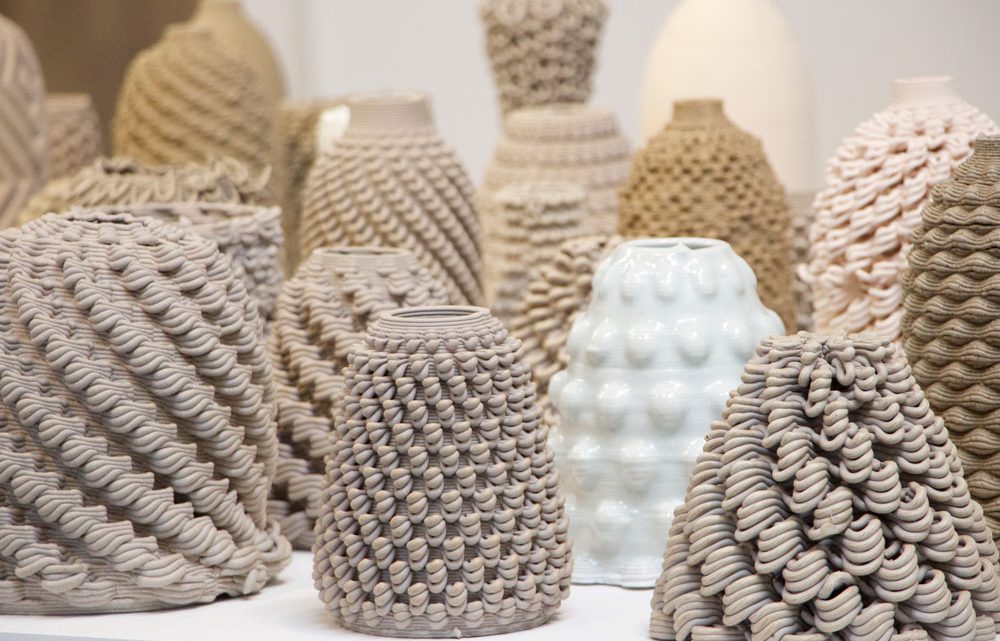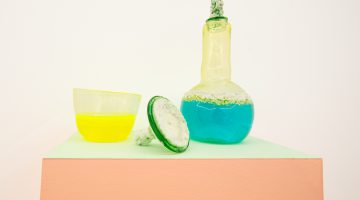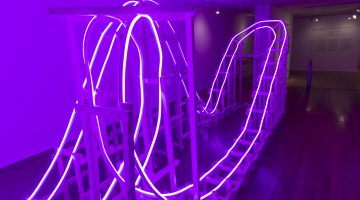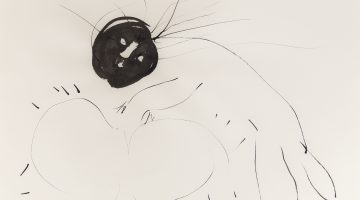Pattern Predictability Repetition
2214
2214 Sixth St., Berkeley CA 94710
February 19 – May 27, 2016
For its first exhibition, 2214—a new Oakland space dedicated to presenting creative, real-world manifestations of a generative and open-ended research and development project—invited two artists and a third artist duo to respond to the prompt of “Pattern Predictability Repetition.” Launched as a multi-volume series, the project was initiated by the architecture and design firm Envelope a+d, whose offices and studios are located in an adjoining set of spaces in the larger one-story building complex that houses the gallery space.
Though the exhibition’s title and thematic point to some implied lockdown of idealized standardization, the reality of its outcomes veers as much toward variability as consistency. Much as music functions through repetitions within genre conventions that generate tensions of anticipation and release, the works in this exhibition leverage givens of purported regularity to produce a far-from-predictable range of effects.
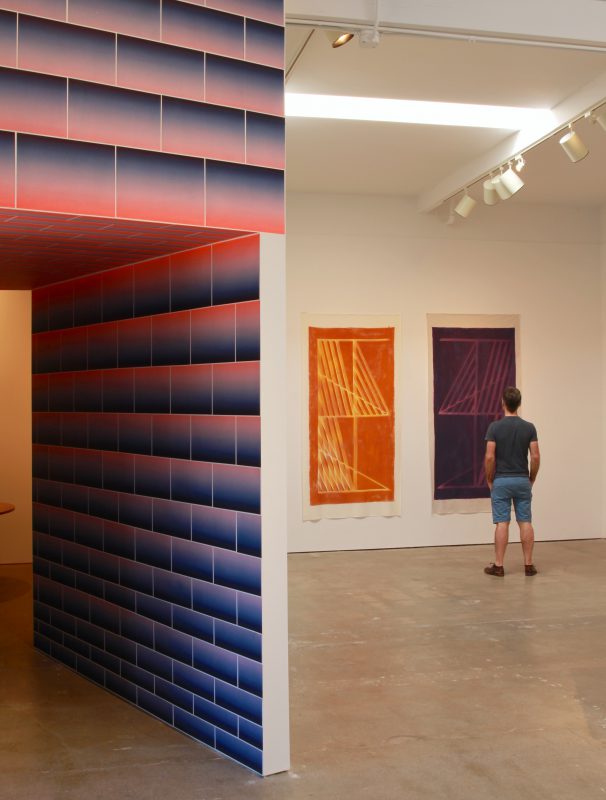
Installation view, Patter Predictability Repetition, 2214, 2016. (Left: Sigrid Calon, A3 risograph paper and wallpaper glue, site-specific installation, Right: Andy Vogt, Untitled (09092015 sepia), 2015. Light oxidized pigment on cotton, 85” x 45” and Untitled (02072016 violet + black), 2016. Light oxidized pigment on cotton, 85” x 45”.
Actual variability occurs, for instance, among the individual components within each individual project’s media and outcomes, ultimately demonstrating the sometimes more expansive ranges of what any set of even highly limited constraints can produce. The different processes can generate divergent trajectories deliberately—as in, for instance, Sigrid Calon’s use of a digital risograph output to map out a range of “brick” images in gradient colors of bright blue and red tightly affixed to the walls and ceiling of an oddly transversal hallway that interrupts the larger space. The effect is to create a subtly shifting set of near horizons and sunset fades via optically commanding wallpaper.
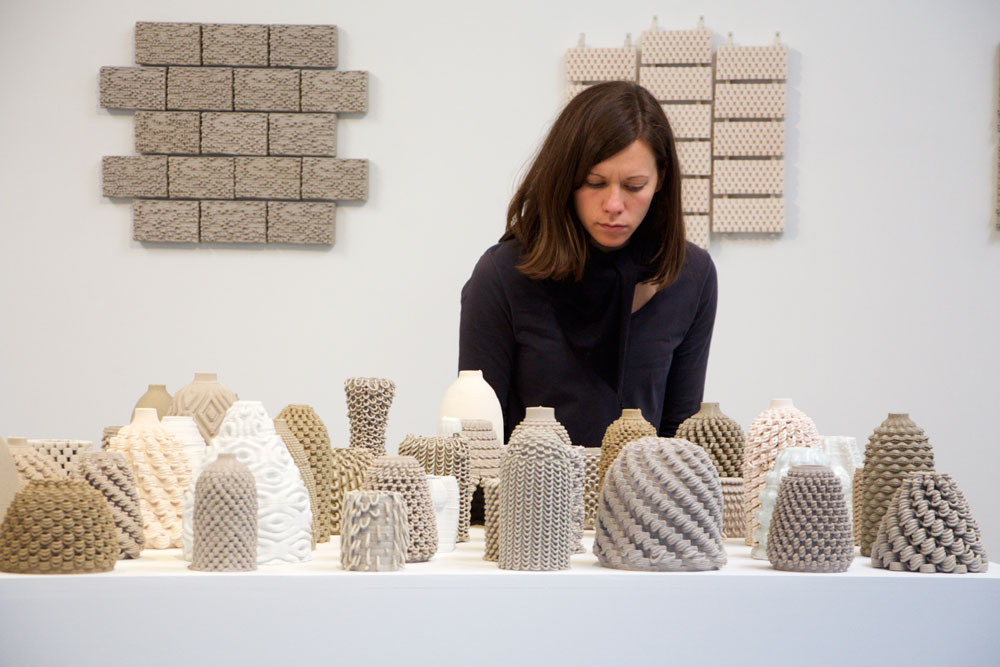
Rael San Fratello, GCODE.Clay, 2016. Courtesy the artists.
For their project in the exhibition, Ronald Rael and Virginia San Fratello shot ceramic material through three-dimensional printing procedures to produce dozens of unique cylindrical and conical vessels that do explore pattern and repetition—nevertheless with varying results. The knobby patterns of the forms’ surfaces come in both glazed and (mostly) unglazed iterations, embodied through different shapes and tapers, and across small ranges of sizes and hues of off-white and light brown. These are arrayed as an ensemble on two large, asymmetrical trapezoidal plinths—as if part of an ethnological display in a natural history museum—with a wall-hanging backdrop of five sets of small rectangular swatches of similar material. These shapes are arranged in larger geometric patterns somewhat akin to fabric samples, paint chips, or construction materials laid out for selection at a hardware store or home improvement shop.
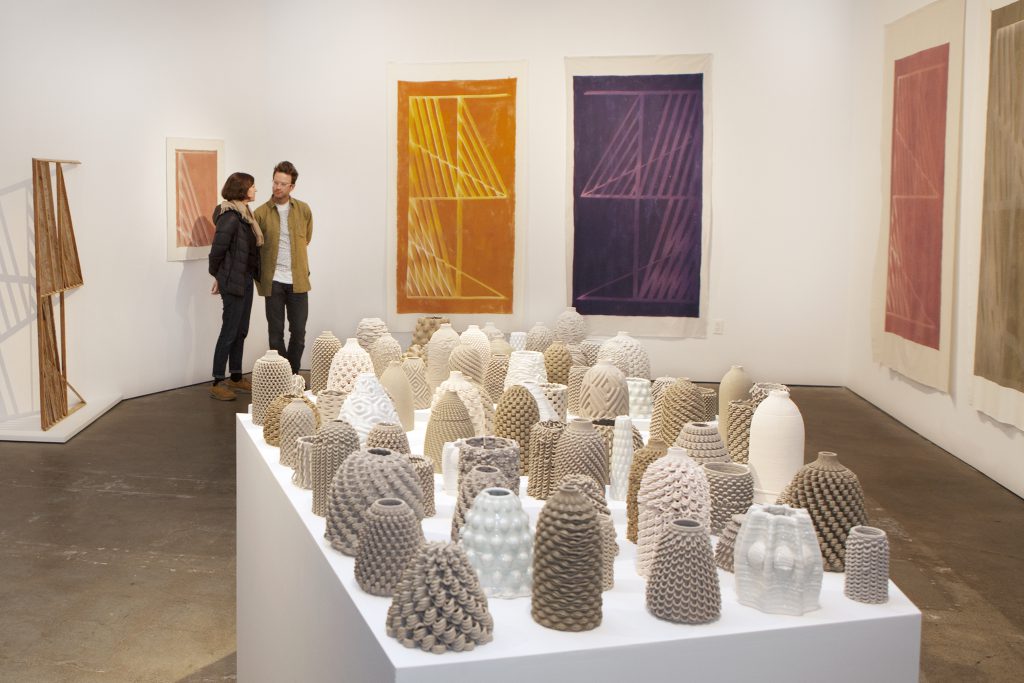
Installation view (GCODE.clay in front), Pattern Predictability Repetition, 2016. Courtesy of 2214.
This commercial/industrial association is not a small thing, given the gallery’s unusual setting proximate to and sponsored by an architectural/design firm. The path to “applied” utility for what might otherwise be seen as somewhat whimsical sculptural works cuts grooves in perception and thinking—presumably deliberate given the genesis of the exhibition in relation to a company that is both intentionally “creative” and “functional” in its goals and particularly with the embrace of newer technological systems so ready-made for commercial/industrial purposes.
The work of Andy Vogt manages best to sidestep and even transcend these more functional and corporate tendencies, with his tracking of variable perceptual phenomenology of light, shadow, and form through his re-purposing of building materials, which impel a particularly human trajectory and affect.
Vogt uses wooden lath—a primary underlying element of building infrastructure—as a surprisingly generative source for a series of artistic translations or transmutations. Despite being a fundamentally physical component long used in construction, the thin slats feel delicate, almost fragile, even when nailed in place in relation to one another in larger frames, and at the same time, their constructedness feels less precise in comparison to the higher tech outputs of the digital processes employed by the other artists in this show. Vogt gets a lot out of this humble material, leveraging its associations with the less-sturdy aspects of construction—especially an almost forlorn aura once it has been wrenched via demolition from its original utility.
Vogt scavenges this material from the discarded remnants of chance-encountered urban building sites. In his re-use, the artist shifts from the tangible form of a set of lath recombined to create photographic images of light and shadow cast by newly rebuilt (and otherwise less purposeful) structures. Proceeding with a selected image of those combined light patterns, he builds newly resolved, physically embodied works, re-using the lath to recreate that combination of prior built form and lines of shadow cast by it.
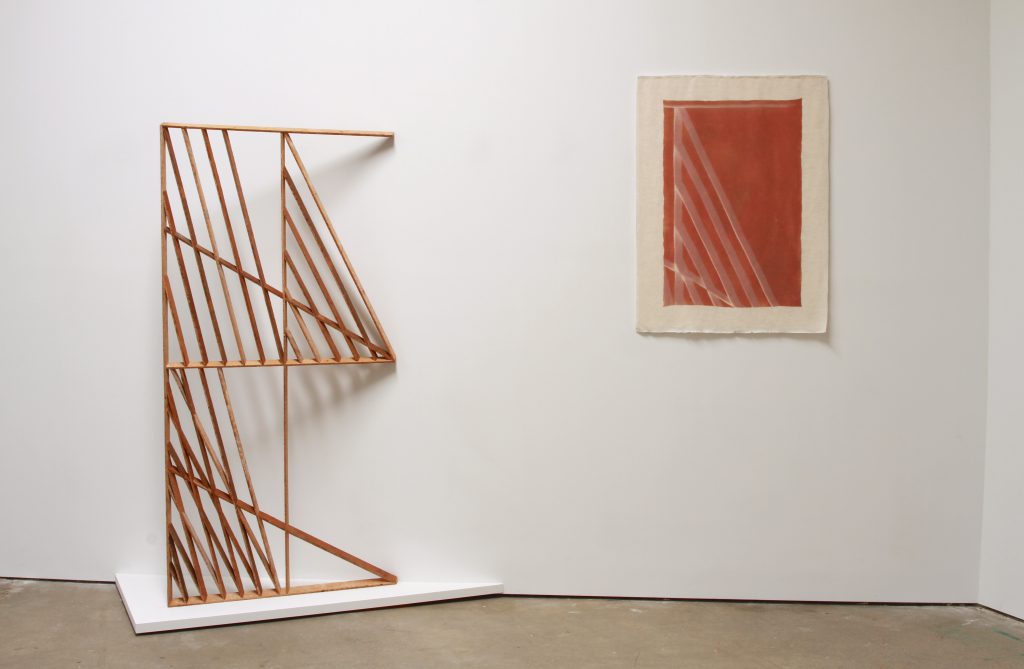
Andy Vogt,Left: Shadeshape 3, 2011. Salvaged wood lath, 71” x 34” x 1.5″. Right: Untitled (02012016 red + green), 2016. Light oxidized pigment on cotton, 37″ X 27.75”.
All this serves as sort of prelude to the most prominent end-products in the exhibition: a set of four large painting-like canvases (and one smaller “detail”), which are hung and left unstretched. Treated with a series of UV sensitive dyes in varying color, the canvases serve as medium for an evocative and unpredictable series of two-dimensional documentation of both three-dimensional qualities of form and four-dimensional temporalities as sunlight was allowed to play freely across the rebuilt lath structure.
For all the practical associations it holds in serving to undergird functional designs, the lath itself—once stripped away, laid bare and brought out into the light—casts a psychological shadow of vulnerability and pathos as well as a phenomenological one of shadow and light. The contingencies of the outdoors, weather, and natural phenomena that the treated canvases are submitted to point to the potential divergences from any simple adherence to the theme of pattern, predictability, and repetition.
Meanwhile, the shifting patterns of Calon’s wallpaper combine an unusual beckoning simultaneously with the elusive extension of horizon lines for visitors to the odd spaces it (re-)defines. These hover near the range of patterns that play out on the inactive utility of the surfaces and forms of Fratello’s vessels (and latently so as well among the more mysterious swatches). Both diverge from any simple repetition, much less predictability. Building on the organic basis of its original material (wood) and its cast-off state, Vogt’s work not only embodies its own newly becoming inutility but also points to the decay and finiteness of those larger built structures that presumably once mattered to humans. This is reminiscent of not only of the ephemerality of all fabricated things as well as the organic elements they are made of, but also of conditions of light and darkness—and of human perception itself—along with the most poignant ephemerality of those affective human states that one might attach to them.
